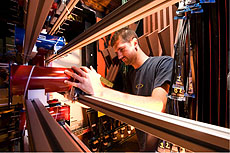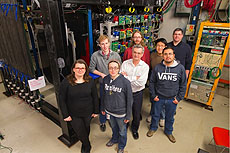The MINERvA test beam program: trust but verify
 |
| This plot shows the energy deposited in the MINERVA test beam detector divided by the incoming kinetic energy of the pion as a function of the kinetic energy of the pion. |
Para una versión en español, haga clic aquí.
All particle physics experiments rely on computer simulations of their detectors to make measurements, but neutrino experiments struggle to test these simulations using particles that are created from the neutrino beam itself.
Neutrino interactions often produce charged particles such as muons or electrons, and they knock one or more protons or neutrons out of the nucleus. Neutrino interactions also produce quark-antiquark pairs called pions (see earlier MINERvA results from February, August and January). Each of these different particles gives us a view inside the nucleus, but to make these precise measurements, MINERvA needs to understand what these particles do once they exit the nucleus and enter the rest of the detector.
We could simply trust a computer package (called Geant4) that simulates particle interactions, but to be rigorous, we verify that package. To do this we use a well-calibrated low-energy beam of pions, protons, muons and electrons from the Fermilab Test Beam Facility and a scaled-down version of the full MINERvA detector that is made of planes of scintillator, lead and steel. This smaller detector, which can be configured to replicate the downstream third of the neutrino detector, uses the same materials, electronics and calibration strategy.
We took data for six weeks in the summer of 2010 using the scaled-down detector and have been poring over this data ever since to measure many different aspects of the way the detector performs.
With these data we were able to address, for one, how the kinetic energy of a pion entering our detector is translated into an energy measurement. When we use a popular Geant4 model for low-energy pions interacting in the simulated detector, the prediction is a good, though not perfect, description of the data. The experiment was designed to test the simulation, and the systematic uncertainties are small enough that we can assign a small uncertainty on how well Geant4 predicts the pion's energy.
We also used the test beam data to measure details about the scintillator material itself to improve the model of the detector geometry and electronics. We also improved how we calibrate both the test beam and the neutrino detector.
We have continually fed back all of these improvements into the neutrino analysis since the test beam program started. This has been a benefit to other programs too. For example, the low-energy beamline design and hardware is now being used in MCenter for the LArIAT experiment.
The results have been recommended for publication in Nuclear Instruments and Methods A. MINERvA has also started a second round of higher-energy test beam measurements to match the new higher-energy neutrino beam to understand still more about the way this detector performs.
—Rik Gran, University of Minnesota – Duluth
 |
| Josh Devan of the College of William and Mary in 2010 helps assemble the low-energy test beam run detector. |
 |
| Pictured here is part of the test beam crew. From left: Anne Norrick (College of William and Mary), Rob Fine (University of Rochester), Carrie McGivern (University of Pittsburgh), Leo Bellantoni, (Fermilab, front), Dan Ruterbories (University of Rochester, in red), Aaron Bercellie (University of Rochester), Manuel Alejandro Ramirez (University of Guanajuato), Geoff Savage (Fermilab). |
|